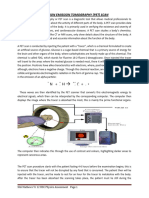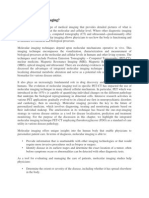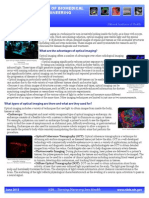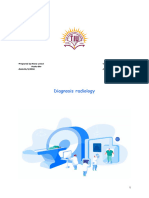BME-417L - PET Scan
BME-417L - PET Scan
Uploaded by
sarmadmukhtar21Copyright:
Available Formats
BME-417L - PET Scan
BME-417L - PET Scan
Uploaded by
sarmadmukhtar21Original Description:
Copyright
Available Formats
Share this document
Did you find this document useful?
Is this content inappropriate?
Copyright:
Available Formats
BME-417L - PET Scan
BME-417L - PET Scan
Uploaded by
sarmadmukhtar21Copyright:
Available Formats
Lab No.
Demonstration of working of Positron Emission Tomography
Objectives
● To understand the basic concepts of PET Scan
● To know the basic parts of PET Scan Machine and how image is generated.
Introduction:
A PET scan, or Positron Emission Tomography scan, is a sophisticated imaging technique used in
medical diagnostics. It enables doctors to observe metabolic processes in the body, providing
insights into the function and structure of organs and tissues. PET scans are particularly valuable
in detecting cancer, evaluating heart conditions, and diagnosing neurological disorders.
The history of PET scans dates back to the mid-20th century, beginning with the development of
the cyclotron by Ernest Lawrence in the 1930s, which enabled the production of positron-
emitting isotopes. The concept of positron emission tomography was first proposed in the 1950s
by American chemist and Nobel laureate Glenn T. Seaborg. In the 1970s, significant
advancements were made with the construction of the first PET scanner by Michael E. Phelps,
Edward J. Hoffman, and their colleagues at Washington University in St. Louis. This breakthrough
allowed for the practical application of PET imaging in medical diagnostics. The 1980s and 1990s
saw further refinements in scanner technology and the development of more sophisticated
tracers, enhancing the accuracy and utility of PET scans. Over the decades, PET scanning has
evolved into a crucial tool in oncology, cardiology, and neurology, transforming medical
diagnostics and patient care.
Working Principle:
A PET scan works by detecting the metabolic activity of cells in the body using a radioactive
tracer. First, a small amount of the tracer, typically a form of glucose tagged with a positron-
emitting radionuclide, is injected into the patient's bloodstream. As the tracer circulates and is
absorbed by tissues with high metabolic rates, such as cancer cells, it undergoes positron
emission decay. When the emitted positrons encounter electrons in the body, they annihilate
each other, producing pairs of gamma photons that travel in opposite directions. The PET
scanner detects these gamma photons with a ring of detectors surrounding the patient. By
analyzing the timing and location of the detected photons, the scanner constructs detailed,
three-dimensional images of tracer concentration within the body, highlighting areas of
abnormal metabolic activity that may indicate disease.
Parts of Machine
Explain at least three following main parts of Mammography Machine.
● Control Panel
The scanning room houses the PET scanner and is designed to ensure patient safety and comfort
while minimizing external interference with the scan. Key aspects of the scanning room include:
PET Scanner: The main component, consisting of a large gantry (the circular part through
which the patient passes) containing detectors that capture gamma rays emitted by the
radiotracer in the patient's body.
Patient Table: A motorized table that moves the patient through the gantry at precise
intervals to capture images of different sections of the body.
Radiation Shielding: The room is often lined with lead or other radiation-absorbing
materials to protect the operators and other individuals in the vicinity from exposure to
radiation.
Environmental Controls: Systems to maintain a comfortable temperature and
atmosphere, as patients need to remain still during the scan. This can include features like
climate control and noise reduction measures.
● Scanning Room
The scanning room houses the PET scanner and is designed to ensure patient safety and comfort
while minimizing external interference with the scan. Key aspects of the scanning room include:
PET Scanner: The main component, consisting of a large gantry (the circular part through
which the patient passes) containing detectors that capture gamma rays emitted by the
radiotracer in the patient's body.
Patient Table: A motorized table that moves the patient through the gantry at precise
intervals to capture images of different sections of the body.
Radiation Shielding: The room is often lined with lead or other radiation-absorbing
materials to protect the operators and other individuals in the vicinity from exposure to
radiation.
Environmental Controls: Systems to maintain a comfortable temperature and
atmosphere, as patients need to remain still during the scan. This can include features like
climate control and noise reduction measures.
● Console Room
The console room is a separate area adjacent to the scanning room, where operators control the
scan and process the data. It ensures that operators are protected from radiation exposure while
they manage the scan. Key components include:
Computers and Workstations: High-powered computers that process the imaging data in
real time, converting the raw data from the detectors into usable images.
Software Applications: Advanced software for image reconstruction, enhancement, and
analysis. This software allows operators to manipulate images to improve clarity and
detail.
Communication Systems: Intercoms and video monitors that enable operators to
communicate with the patient and monitor the scanning room visually, ensuring patient
safety and comfort.
Data Storage and Networking: Systems for storing the large amounts of data generated
by PET scans and integrating with hospital networks and databases for patient records
and image sharing.
Results:
Figure 1 PET scan machine
Discussion:
Applications of PET Scans
Oncology: PET scans are extensively used in the detection, staging, and monitoring of
cancer. They help identify the presence and spread of tumors, evaluate the effectiveness
of treatments, and detect recurrences. PET scans can differentiate between benign and
malignant lesions, making them a critical tool in cancer diagnosis and management.
Cardiology: In cardiology, PET scans assess blood flow to the heart and identify areas of
reduced blood flow, which can indicate coronary artery disease. They are also used to
evaluate myocardial viability, helping to determine whether damaged heart tissue can
benefit from procedures like angioplasty or bypass surgery.
Neurology: PET scans are valuable in diagnosing and managing neurological disorders.
They can detect abnormalities in brain metabolism associated with conditions such as
Alzheimer's disease, epilepsy, and Parkinson's disease. PET scans help in identifying the
regions of the brain affected by these disorders, aiding in accurate diagnosis and
treatment planning.
Infectious Diseases and Inflammation: PET scans can detect areas of infection or
inflammation in the body. They are used to locate sources of unexplained fevers, identify
infections in bones (osteomyelitis), and monitor inflammatory diseases such as vasculitis
and inflammatory bowel disease.
Psychiatry: In psychiatric research, PET scans are used to study brain function and
investigate the biochemical basis of mental disorders such as depression, schizophrenia,
and bipolar disorder. They help researchers understand how these conditions affect brain
activity and metabolism.
Research and Drug Development: PET scans play a crucial role in biomedical research and
the development of new drugs. They are used to study the pharmacokinetics and
pharmacodynamics of new medications, observe their effects on the body, and evaluate
their efficacy in clinical trials.
Benefits of PET Scans
Early Detection: PET scans can detect diseases at their earliest stages, often before
symptoms appear, which is crucial for conditions like cancer where early detection
significantly improves treatment outcomes.
Detailed Images: PET scans provide high-resolution, three-dimensional images of the
body's metabolic activity, allowing for precise localization and characterization of
abnormalities.
Functional Information: Unlike other imaging techniques that primarily show anatomical
structures, PET scans provide functional information about tissues and organs, helping to
identify abnormal metabolic processes.
Treatment Monitoring: PET scans are valuable for monitoring the effectiveness of
treatments, such as chemotherapy or radiation therapy, by showing changes in metabolic
activity within tumors or other affected tissues.
Comprehensive Assessment: PET scans can be combined with CT or MRI scans to provide
comprehensive information about both the structure and function of tissues, enhancing
diagnostic accuracy.
Risks of PET Scans
Radiation Exposure: PET scans involve exposure to a small amount of radiation from the
radioactive tracer. Although the dose is generally low, repeated exposure or exposure
during pregnancy can pose risks, making it unsuitable for certain populations.
Allergic Reactions: While rare, some patients may experience allergic reactions to the
radioactive tracer used in PET scans. Symptoms can range from mild (such as itching or
rash) to severe (such as difficulty breathing).
Limited Availability and Cost: PET scans are complex and expensive procedures that may
not be readily available in all medical facilities. The high cost can also be a barrier for
some patients, especially if not fully covered by insurance.
False Positives/Negatives: Like all diagnostic tests, PET scans are not infallible. They can
sometimes produce false-positive results, indicating disease where there is none, or false-
negative results, missing an existing condition. These inaccuracies can lead to
unnecessary anxiety or missed diagnoses.
Preparation and Procedure Time: The procedure requires specific preparation, such as
fasting, and can be time-consuming, including the wait for the tracer to circulate and the
actual scanning process. This can be inconvenient for some patients.
What is a PET scan?
A positron emission tomography (PET) scan is an imaging test that produces images of your
organs and tissues at work. The test uses a safe, injectable radioactive chemical called a
radiotracer and a device called a PET scanner.
The scanner detects diseased cells that absorb large amounts of the radiotracer, which indicates
a potential health problem.
Healthcare providers frequently use PET scans to help diagnose cancer and assess cancer
treatment. They can also assess certain heart and brain issues with the scan.
What’s the difference between a PET scan, CT scan and MRI?
Computed tomography (CT) scans use X-rays. Magnetic resonance imaging (MRI) scans use
magnets and radio waves. Both produce still images of organs and body structures.
PET scans use a radioactive tracer to show how an organ is functioning in real time. PET scan
images can detect cellular changes in organs and tissues earlier than CT and MRI scans. Your
healthcare provider may perform a PET scan and CT scan at the same time (PET-CT). This
combination test produces 3D images that allow for a more accurate diagnosis.
Some hospitals now use a hybrid PET/MRI scan. This new technology creates extremely high-
contrast images. Providers mainly use this type of scan for diagnosing and monitoring cancers of
the soft tissues (brain, head and neck, liver and pelvis).
What does a PET scan check for?
Your healthcare provider may order a PET scan to check for signs of:
Cancer, including breast cancer, lung cancer and thyroid cancer.
Coronary artery disease, heart attack or other heart problems.
Brain disorders, such as brain tumors, epilepsy, dementia and Alzheimer’s disease.
When would I need a PET scan?
In general, a PET scan can measure vital functions, such as blood flow, oxygen use and blood
sugar (glucose) metabolism. It can also identify organs and tissues that aren’t working as they
should.
If your healthcare provider suspects you may have cancer, they’ll likely recommend a PET scan,
which can detect cancer and/or make a diagnosis.
If you’ve already been diagnosed with cancer, your provider may recommend more than one PET
scan throughout your treatment to:
Determine whether the cancer has spread in your body (metastasized).
Assess the effectiveness of treatment.
Determine if the cancer has returned after treatment (recurred).
Evaluate the prognosis (outlook) of the cancer.
If you’re having heart issues, your provider may recommend a PET scan to:
Determine the effects of a heart attack on areas of your heart.
Identify areas of the heart muscle that would benefit from angioplasty or coronary artery
bypass surgery.
If you’re experiencing neurological symptoms, your provider may recommend a PET scan to
evaluate possible brain abnormalities, such as tumors, seizures and other central nervous system
conditions.
How do I prepare for a PET scan?
PET scans are an outpatient procedure, which means you go home the same day. Your
healthcare provider will give you detailed instructions on how to prepare for the scan. In general,
you should:
Make sure your provider has a current list of all medications, vitamins and supplements
you take, as well as any allergies you have.
Alert your provider if you think you could be pregnant or if
you’re breastfeeding (chestfeeding).
Not eat anything for six hours before the test. Your healthcare provider may change this
direction if you have diabetes.
Drink only water.
Avoid caffeine for 24 hours before the test if you’re being tested for a heart problem.
Wear comfortable clothes and leave metal accessories, such as jewelry, eyeglasses,
dentures and hairpins at home.
Tell your healthcare provider if being in an enclosed space makes you anxious. You may
be able to take a mild sedative to help you relax during the procedure.
What should I expect during a PET scan?
You can expect the following during a PET scan:
You’ll receive an IV injection of a radiotracer that contains a safe amount of a radioactive
drug. The most commonly used radiotracer is fluorodeoxyglucose (FDG).
You’ll sit in a chair for about an hour while the radiotracer moves through your
bloodstream and gets absorbed by your organs and tissues. Too much activity can send
the radiotracer to areas of your body that your healthcare provider isn’t testing. You
won’t be able to feel the radiotracer.
If you’re getting a PET/CT scan, you may also get an IV injection of a contrast dye. This dye
helps produce sharper CT images.
You’ll lie on an exam table that slides in and out of the PET/CT scanner. This scanner is
shaped like a doughnut. The doughnut or tunnel opening is about 30 inches in diameter.
During the scan, which usually takes about 30 minutes, you must remain still. Movement
can blur the images.
You’ll hear buzzing and clicking sounds as the scanner takes images.
A technologist will review the scans before you leave to ensure the images are in focus.
How long does a PET scan take?
The entire PET scan process takes about two hours.
It can take up to 60 minutes for your body to absorb the injected radiotracer. During this time,
you’ll need to sit quietly and limit your movements. The actual PET scan takes about 30 minutes.
After the test, you’ll need to wait while the technologist reviews the scans to ensure the images
are clear.
References:
https://www.x-zlab.com/pet-imaging/
https://my.clevelandclinic.org/health/diagnostics/10123-pet-scan
https://www.radiologyinfo.org/en/info/pet
https://www.healthdirect.gov.au/pet-scan
You might also like
- Bio Physics AssignmentDocument8 pagesBio Physics AssignmentAli InamNo ratings yet
- Scope of Diagnostic Imaging in Veterinary PracticeDocument9 pagesScope of Diagnostic Imaging in Veterinary PracticeAbdul RehmanNo ratings yet
- Imaging Modalities in RadiologyDocument44 pagesImaging Modalities in Radiologyazimatun nikmah100% (1)
- 2008 Physics Assessment TaskDocument3 pages2008 Physics Assessment TasknealNo ratings yet
- PET ScanDocument3 pagesPET ScanChim PalmarioNo ratings yet
- What Is Molecular Imaging?Document10 pagesWhat Is Molecular Imaging?Akshat SinghNo ratings yet
- Scanning TechDocument9 pagesScanning Techabhijiths64095No ratings yet
- PET - CT ScanningDocument8 pagesPET - CT ScanningBMTNo ratings yet
- Class NotesDocument4 pagesClass NotesSamrat banerjeeNo ratings yet
- Positron Emission Tomography - Computed Tomography (PET/CT)Document8 pagesPositron Emission Tomography - Computed Tomography (PET/CT)Anonymous t5TDwdNo ratings yet
- NNEWDDDocument8 pagesNNEWDDAmolSuhasVedpathakNo ratings yet
- What Is Medical Equipment and Types of Medical EquipmentDocument5 pagesWhat Is Medical Equipment and Types of Medical EquipmentNor Hassan AmbaNo ratings yet
- PETCT - Positron Emission TomographyComputed ToDocument1 pagePETCT - Positron Emission TomographyComputed ToSaad ManzoorNo ratings yet
- Optical Imaging Fact SheetDocument2 pagesOptical Imaging Fact SheetFeby Shyntia AfirantiNo ratings yet
- Positron Emission Tomographic ScanningDocument10 pagesPositron Emission Tomographic ScanningVenugopal ParthasarathyNo ratings yet
- Prabhsharn cl21m012Document12 pagesPrabhsharn cl21m012prabhsharn SinghNo ratings yet
- Diagnostic Imaging Procedures - SFDocument33 pagesDiagnostic Imaging Procedures - SFSusan FNo ratings yet
- Nuclear Medicine: Definition of The Specialty and Scope of Nuclear MedicineDocument23 pagesNuclear Medicine: Definition of The Specialty and Scope of Nuclear MedicinePriya SalunkeNo ratings yet
- Veterinary Diagnostics TechniquesDocument5 pagesVeterinary Diagnostics Techniquesmarcus ciceroNo ratings yet
- What Is Molecular ImagingDocument4 pagesWhat Is Molecular ImagingSatish G KulkarniNo ratings yet
- BiophysicsDocument9 pagesBiophysicshazharomar958No ratings yet
- CT Scan, Mri, Pet ScanDocument5 pagesCT Scan, Mri, Pet ScanAmit MartinNo ratings yet
- BAB IIRadiology Is A Specialty That Uses Medical Imaging To Diagnose and Treat Diseases Seen Within The BodyDocument7 pagesBAB IIRadiology Is A Specialty That Uses Medical Imaging To Diagnose and Treat Diseases Seen Within The BodySupian Ats-tsauriNo ratings yet
- PetDocument10 pagesPetZero ZeroNo ratings yet
- BiophyDocument16 pagesBiophypj2g2phmykNo ratings yet
- Photon Emission Computed TomographyDocument27 pagesPhoton Emission Computed TomographyANDREW ODHIAMBONo ratings yet
- Nuclear Chemistry in Medicine-1Document2 pagesNuclear Chemistry in Medicine-1Dida EldiraNo ratings yet
- Topic 26Document11 pagesTopic 26api-376527663No ratings yet
- Biomedical Image AnalysisDocument6 pagesBiomedical Image Analysisrahuldantewadia181No ratings yet
- Current Diagnostic Techniques in Veterinary Surgery PDFDocument2 pagesCurrent Diagnostic Techniques in Veterinary Surgery PDFKirti JamwalNo ratings yet
- Slide 7 - PETDocument11 pagesSlide 7 - PETMr RobotNo ratings yet
- Nuclear MedicineDocument11 pagesNuclear MedicineJose Nicolielly100% (1)
- Nuclear MedicineDocument10 pagesNuclear Medicinehomam Salim KhalafNo ratings yet
- Pet Scan: What Are Some Common Uses of The Procedure?Document6 pagesPet Scan: What Are Some Common Uses of The Procedure?Dyah AyuNo ratings yet
- Scan Tehc.Document23 pagesScan Tehc.senlerselvanNo ratings yet
- Types of ScanPSY105Document2 pagesTypes of ScanPSY105h_brandonNo ratings yet
- Assignment # 1: Hanya Khan, Habiba RiazDocument10 pagesAssignment # 1: Hanya Khan, Habiba RiazFaisal AwanNo ratings yet
- 180 Careers Diagnostic ServicesDocument45 pages180 Careers Diagnostic ServiceshkkNo ratings yet
- Biomedical Unit - 2 - ImagingDocument13 pagesBiomedical Unit - 2 - ImagingShravani HoreNo ratings yet
- ML_MedicalIMagesDocument2 pagesML_MedicalIMagesanipri2009No ratings yet
- A PET-CT INSTRUMENT DAN APLIKASI KLINIK - Pengantar Pencitraan Diagnostik MutakhirDocument20 pagesA PET-CT INSTRUMENT DAN APLIKASI KLINIK - Pengantar Pencitraan Diagnostik Mutakhir16 generation Radiology100% (1)
- TechnicalDocument20 pagesTechnicalArun KNo ratings yet
- Pet Scan Under Supervision of Dr. Alaa Mushatet: Zahraa Ali RazzaqDocument6 pagesPet Scan Under Supervision of Dr. Alaa Mushatet: Zahraa Ali Razzaqalaa mushatet hammadiNo ratings yet
- Brain Imaging Technologies and Their Applications in NeuroscienceDocument45 pagesBrain Imaging Technologies and Their Applications in NeuroscienceNeea AvrielNo ratings yet
- FileDocument4 pagesFileJowayne HudsonNo ratings yet
- Use and Significance of Radioisotopes in BiochemistryDocument3 pagesUse and Significance of Radioisotopes in Biochemistryminahil9204No ratings yet
- Positron Emission Tomography: Presented by Kalyani ShindeDocument25 pagesPositron Emission Tomography: Presented by Kalyani ShindeKalyani ShindeNo ratings yet
- Computed TomographyDocument3 pagesComputed TomographyZainab NaeemNo ratings yet
- Bme ReportDocument15 pagesBme ReportnikitatayaNo ratings yet
- Radiologists: Chronicle Guidance Publications Brief 462Document4 pagesRadiologists: Chronicle Guidance Publications Brief 462Madison DahseNo ratings yet
- Diagnostic ImagingDocument25 pagesDiagnostic Imagingprakritibhatnagar1511No ratings yet
- Diagnostic ImagingDocument25 pagesDiagnostic Imagingprakritibhatnagar1511No ratings yet
- Kempchandleri SearchpaperDocument8 pagesKempchandleri Searchpaperapi-321353327No ratings yet
- Nguyễn Thái Hoàng Duy Ksor Y Linh Thư Nguyễn Đỗ Thuý HằngDocument12 pagesNguyễn Thái Hoàng Duy Ksor Y Linh Thư Nguyễn Đỗ Thuý HằngPhúc NguyễnNo ratings yet
- Nuclear MedicineDocument25 pagesNuclear MedicineRafal100% (1)
- Document from $yed@ $o$un Z@hr@ N@qvi..Document23 pagesDocument from $yed@ $o$un Z@hr@ N@qvi..Sosun ZahraNo ratings yet
- XRAYSDocument10 pagesXRAYSkeeratkbediNo ratings yet
- Medical Physics Course Notes (Greg Pitt)Document92 pagesMedical Physics Course Notes (Greg Pitt)Mel ClancyNo ratings yet
- The Application of Nuclear Physics in Biology and Medicine 1Document7 pagesThe Application of Nuclear Physics in Biology and Medicine 1essaidNo ratings yet
- Textbook of Urgent Care Management: Chapter 35, Urgent Care Imaging and InterpretationFrom EverandTextbook of Urgent Care Management: Chapter 35, Urgent Care Imaging and InterpretationNo ratings yet
- Chapter 9 Hospital Pharmacy Notes Complete Notes by Noteskarts Acc To ER20Document5 pagesChapter 9 Hospital Pharmacy Notes Complete Notes by Noteskarts Acc To ER20Mobeen AhmedNo ratings yet
- Robin's HistopathDocument6 pagesRobin's HistopathKennedy DelrosarioNo ratings yet
- Textbook of Nephrology (Anil K Mandal) (Z-Library)Document511 pagesTextbook of Nephrology (Anil K Mandal) (Z-Library)chitraNo ratings yet
- GERD ManagementDocument43 pagesGERD ManagementpashaNo ratings yet
- The Steroid Withdrawal Syndrome: A Review of The Implications, Etiology, and TreatmentsDocument5 pagesThe Steroid Withdrawal Syndrome: A Review of The Implications, Etiology, and TreatmentsChristopher Surya SuwitaNo ratings yet
- Gene TherapyDocument6 pagesGene TherapyCrazyNo ratings yet
- Art 3 Non-Alcoholic Fatty Liver Disease ADocument10 pagesArt 3 Non-Alcoholic Fatty Liver Disease AAlexsander SarmientoNo ratings yet
- Parasitology TableDocument15 pagesParasitology TableJohn Benedict BondocNo ratings yet
- ABG Analysis in Clinical Setting: Rajesh Mahajan, Suman SethiDocument5 pagesABG Analysis in Clinical Setting: Rajesh Mahajan, Suman SethiLord GrimmNo ratings yet
- GrammarDocument16 pagesGrammarSenanur GökşinNo ratings yet
- Dermatitides, Eczema, NeurodermatoseDocument20 pagesDermatitides, Eczema, NeurodermatoseElephant ksmileNo ratings yet
- Furosemide Summary Report Committee Veterinary Medicinal Products enDocument9 pagesFurosemide Summary Report Committee Veterinary Medicinal Products enLucijaRomićNo ratings yet
- Humalog Drug StudyDocument3 pagesHumalog Drug StudyKristinelou Marie Reyna100% (1)
- 1.a. SGT - Pharmacotherapy of TB - Based On NTEPDocument59 pages1.a. SGT - Pharmacotherapy of TB - Based On NTEPNisarg KundarNo ratings yet
- Fisa de Disciplina - ENG - Reumatologie - 2019 - 2020Document4 pagesFisa de Disciplina - ENG - Reumatologie - 2019 - 2020flo108No ratings yet
- VaginitisDocument27 pagesVaginitisdrtancerNo ratings yet
- PART 1 Biologic Basis of PeriodontologyDocument3 pagesPART 1 Biologic Basis of PeriodontologyNurul HidayatiNo ratings yet
- Case-Study Hemorrhagic-Stroke FinalDocument102 pagesCase-Study Hemorrhagic-Stroke FinalAngela QuiñonesNo ratings yet
- Drug StudyDocument34 pagesDrug Studypoleene de leonNo ratings yet
- Physiotherapy-modules-1Document18 pagesPhysiotherapy-modules-1Tony YZNo ratings yet
- Renal and Genitourinary ConditionsDocument139 pagesRenal and Genitourinary ConditionsjustinahorroNo ratings yet
- Orthopedic Syllabus @shamimDocument3 pagesOrthopedic Syllabus @shamimFojal AhmedNo ratings yet
- Final Thesis 2018 08 23 18 13 33 319 PDFDocument69 pagesFinal Thesis 2018 08 23 18 13 33 319 PDFPriyanka KanodiaNo ratings yet
- Nursing Care Plan: Cues Analysis Nursing Diagnosis Goal and Objectives Intervention Rationale Evaluation SubjectiveDocument6 pagesNursing Care Plan: Cues Analysis Nursing Diagnosis Goal and Objectives Intervention Rationale Evaluation SubjectiveKristel PunoNo ratings yet
- EeeeeeDocument322 pagesEeeeeeABCD ENo ratings yet
- DivalproexDocument2 pagesDivalproexeefrheel0% (1)
- NICABM JohnArden Brain2014Document22 pagesNICABM JohnArden Brain2014acehussain100% (1)
- Admission Criteria Dengue FeverDocument23 pagesAdmission Criteria Dengue FeverMuhammad Luthfi TaufikNo ratings yet
- NBDE RECALL-421ipassDocument43 pagesNBDE RECALL-421ipassSaif PathanNo ratings yet
- Fluid and ElectrolytesDocument102 pagesFluid and ElectrolytesBindiya MangarNo ratings yet

























































































